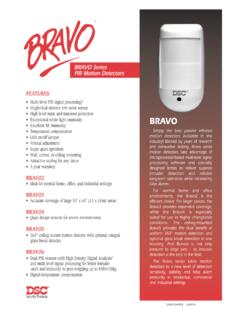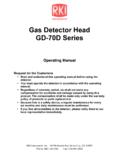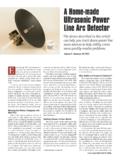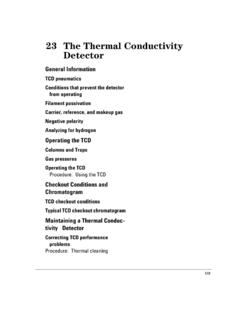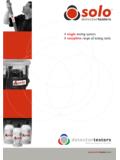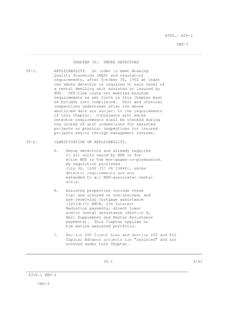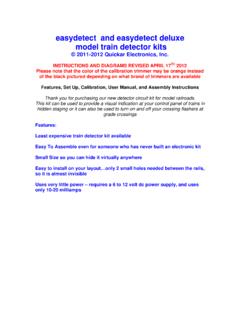Transcription of ESL 500N Series C UL US Smoke Detector - …
1 Auxiliary and end-of-line relays ESL 500n Series C. UL.. LISTED. US Auxiliary relays are form C and operate at 1A @ 30 VDC to allow for the addition of auxiliary notification devices to the Smoke Detector Smoke loops. Products with an R in the suffix signify the auxiliary relay feature. An end-of-line relay operates as a power supervision relay and Installation Instructions is normally energized and will release with the loss of power. Products with an E in the suffix signify the end-of-line feature. WARNING. This document is intended for licensed electricians/ Heat sensors alarm installers. GE Interlogix cannot provide technical Some models come with both a rate-of-rise and fixed tempera- support to unqualified persons.
2 Ture heat sensors which allows the unit to detect changes in temperature that may signal a fire event. Models with an XT . If you have questions, call GE Interlogix at 1-800-648-7424. in the suffix have a heat sensor included. Some models are available with an isolated heat sensor. If the Description unit senses a temperature change it will alert the panel and The ESL 500n Series conventional 2-wire and 4-wire photoelectric signal an alarm independent of Smoke in the photoelectric Smoke detectors have intelligent software and digitally processed chamber. The heat alarm output is on the alarm relay and the sensing capabilities. This intelligence coupled with the ESL patented Smoke alarm output is on the auxiliary relay.
3 Models with an optical sensing chamber means the ESL 500n Series quickly and H in the suffix have an isolated heat sensor which is both rate- accurately detects Smoke . CleanMe compatible software, self- of-rise and fixed temperature. diagnostics, and dust (drift) compensation are standard in every unit. Convertible inputs The ESL 500n Series offers application flexibility with optional The 2-wire 500n Series can be converted using the ESL 505. auxiliary relays, rate-of-rise/fixed temperature heat sensors, isolated module to a 4-wire input on the control panel. The 500n Series heat sensors and/or 85dBa temporal 3 sounders. is UL Listed as compatible with the 505 module and will be All models ship standard with the following features: fully UL compliant with any UL listed 24 VDC control panel Detector /base lock and panels that do not operate below 12V.
4 Up to 20 ESL 500n . Discourages unauthorized removal of the Smoke Detector by requiring Series Smoke detectors can be accomodated on each 505. a screwdriver to remove the Detector from the base. module. See the 505 module installation instructions for more Self-diagnostics information. Includes automatic sensitivity testing. Once a day and immediately Compatibility upon first power up, each 500n Series Detector performs a full Please refer to the ESL Compatibility Index for a complete diagnostic test that includes a dynamic test of the sensing chamber listing of control panels and proper identifiers. For a copy and internal electronics. This meets NFPA 72 field sensitivity testing of the Compatibility Index, call 1-800-648-7424 or visit requirements without the need for external meters.
5 For a copy to download. Remember, Drift compensation (dust compensation) 4-wire Smoke detectors do not require a compatibility listing. The detectors automatically adjust sensitivity, up to a maximum of , as the detectors become dirty. Dining Kitchen Bedroom Bedroom Room Automatic voltage range selection for UL 2-wire compatibility 1A. The 2-wire 500n Series detectors automatically determine if the Detector is connected to a 6/12V panel or a 12/24V panel. There are Living Room Bedroom no switches to set. Depending on the model, the Smoke Detector provides the following features: Dining Kitchen Bedroom CleanMe TV Room Room 1B. Enables the control panel to receive a warning signal via a 505.
6 Module, or CleanMe compatible panel, indicating that the optical Living Room Bedroom chamber needs to be replaced. This feature is available on the 500n . Series 2-wire detectors only. The 500n Series 2-wire detectors enable the CleanMe function by Bedroom recognizing voltage polarity at installation. If the + and - terminal connections are reversed, the CleanMe function is enabled. New 500n Series detectors are compatible on the same loop with previous 500 Series detectors if proper wiring is observed. See Figure 5. Integral Temporal 3 Sounder In the 500n models with sounder, a piezoelectric horn produces an 1C. Bedroom Bedroom interrupted 85dBa tone when the Detector alarms or when the polarity is reversed.
7 Sounder follows input voltage in reverse polarity. Living Dining Room Room In order for all sounders to activate when the panel alarms, the panel must reverse the supply voltage polarity to the loop on alarm. If the Basement panel does not implement polarity reversal, an ESL 405 Polarity Reversal Relay Module must be used. (Refer to the installation = Required Smoke detectors instructions for the ESL 405 Polarity Reversal Relay Module.) = Additional Smoke detectors required for new construction Figure 1. Detector placement ESL 500n Series 1. Selecting a Location Installing the Detector Selecting a suitable location is critical to the operation of Smoke All wiring must conform to the National Electric Code (NEC) and/.
8 detectors . This equipment should be installed in accordance with or local codes having jurisdiction. Use 12 to 24 AWG (16 to the National Fire Protection Association's (NFPA) Standard 72. 22 AWG recommended) wire to install the Detector . Where to Locate the Required Smoke detectors in 1. If you are using the Detector /base lock, remove the Detector Existing Construction. The major threat from fire in a family living knockout and break off the tab on the mounting base. See unit occurs at night when everyone is asleep. The principal threat Figure 2. to persons in sleeping areas comes from fires in the remainder of 2. Remove the red plastic cover from the Detector .
9 The the unit. Therefore, a Smoke Detector (s) is best located between the Detector is shipped with a cover for protection against bedroom areas and the rest of the unit. In units with only one construction site dust. bedroom area on one floor, the Smoke Detector (s) should be located 3. Run system wiring to the Detector location and mount as shown in Figure 1 A. electrical boxes if necessary. The Detector fits standard In family living units with more than one bedroom area or with single gang boxes and 3 1/2 and 4 round ceiling boxes. bedrooms on more than one floor, more than one Smoke Detector is 4. Line up and attach the mounting base to the electrical box, required, as shown in Figure 1 B.
10 Wall or ceiling using the screws provided. Use the wall In addition to Smoke detectors outside of the sleeping areas, the anchors if necessary. See Figure 3. installation of a Smoke Detector on each additional story of the 5. Strip the system wires and connect them to the appropriate family living unit, including the basement, is required. These terminals on the Detector . See Figure 5. installations are shown in Figure 1 C. The living area Smoke Detector should be installed in the living room or near the stairway 6. Attach the Detector to the mounting base as follows: to the upper level, or in both locations. The basement Smoke - Line up the raised tab on the side of the Detector with the Detector should be installed in close proximity to the stairway arrow on the mounting base.
